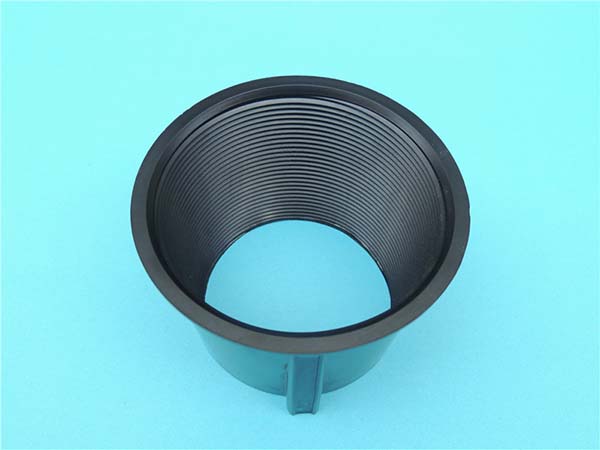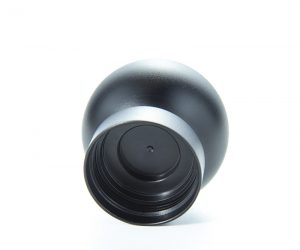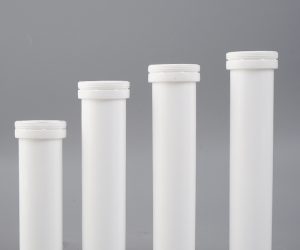Introduction
Baquelite material, also known as phenol - formaldehyde resin, is a groundbreaking synthetic material that has left an indelible mark on the history of materials science and manufacturing. Invented in 1907 by the Belgian - born American chemist Leo Hendrik Baekeland, Baquelite was the world's first truly synthetic resin. Before its advent, plastics were mainly based on modified natural materials, but Bakelite was made through a chemical combination of phenol and formaldehyde, which were derived from coal tar and wood alcohol (methanol) respectively at that time.
This material is a hard, infusible, and chemically resistant plastic. Its unique properties have made it suitable for a wide range of applications since its invention. However, as new materials have emerged over the years, understanding the specific uses, characteristics, and distinctions of Bakelite can be a bit confusing for many.
Yigu Technology aims to comprehensively address the common questions and doubts users have regarding the practical applications of Bakelite material. Whether you are a DIY enthusiast looking for suitable materials for a project, a student studying materials science, or a professional in an industry that might potentially use Bakelite, by the end of this article, you will have a clear understanding of Bakelite's capabilities, limitations, and where it can be most effectively applied in real - world scenarios.
What is Bakelite Material?
Definition and Chemical Composition
Bakelite material is a type of plastic based on phenol - formaldehyde resin. It is formed through a chemical reaction between phenol and formaldehyde. Phenol, at that time, was derived from coal tar, a by - product of coal processing in the coking industry. Coal tar contains a complex mixture of organic compounds, and phenol can be separated and purified from it. Formaldehyde, on the other hand, was obtained from wood alcohol (methanol). Methanol could be produced through the destructive distillation of wood. When phenol and formaldehyde react under specific conditions, they form a three - dimensional cross - linked polymer structure, which gives Bakelite its unique properties. This chemical composition makes Bakelite the first truly synthetic resin, as it is not based on modified natural materials like earlier plastics.
Invention and Development History
The invention of Bakelite is credited to the Belgian - born American chemist Leo Hendrik Baekeland. In the early 20th century, Baekeland was conducting research on the reaction between phenol and formaldehyde. Previous experiments by other chemists, such as Adolf von Baeyer in 1872, had only produced viscous liquids or brittle solids of no apparent value. Baekeland, however, was able to control the phenol - formaldehyde condensation reaction. In 1907, he patented his invention, which was a significant milestone in the history of plastics.
In 1909, Baekeland made the first public announcement of his invention in a lecture before the New York section of the American Chemical Society. By 1910, he had established a semi - commercial production operation in his laboratory, and the General Bakelite Company began operations in Perth Amboy, N.J., U.S. In the early days, Bakelite faced competition from celluloid, a highly flammable and heat - sensitive plastic that was the dominant material in the plastics market at the time. However, Bakelite's unique properties, such as its insolubility and infusibility, made it more desirable for certain applications.
Over the years, the production and application of Bakelite continued to expand. In the 1920s, it was widely used in knobs, dials, circuitry panels, and even cabinets for radios, and also found its way into the electrical systems of automobiles. In the 1930s, cast Bakelite was popular in colorful costume jewelry and novelties. The Bakelite patent expired in 1927, which led to increased competition in the market. In 1939, Baekeland sold the Bakelite trademark to the Union Carbide and Carbon Corporation, and later, in 1992, Union Carbide sold it to the Georgia - Pacific Corporation, which used Bakelite as a bonding agent for plywood and particleboard. Even today, Bakelite is still commonly used for dominoes, mah - jongg tiles, checkers, and chess pieces.
Properties of Bakelite Material
Mechanical Properties
Bakelite material is known for its high mechanical strength. It has a relatively high hardness, which makes it suitable for applications where wear - resistance is required. For Yigu Technology example, when compared to some common plastics like polyethylene (PE) and polypropylene (PP), Bakelite has a much higher hardness value. The Shore D hardness scale, which is often used to measure the hardness of plastics, shows that Bakelite can have a hardness value in the range of 85 - 90 Shore D, while low - density polyethylene typically has a hardness of around 40 - 50 Shore D. This high hardness allows Bakelite to maintain its shape and integrity even under moderate mechanical stress.
In terms of tensile strength, Bakelite also performs well. The tensile strength of Bakelite can reach up to 40 - 60 MPa, depending on the specific formulation and manufacturing process. In contrast, the tensile strength of general - purpose polystyrene (PS) is usually in the range of 35 - 50 MPa. This means that Bakelite can withstand greater pulling forces without breaking, making it suitable for applications such as gears, cams, and other mechanical components in machinery.
Another remarkable mechanical property of Bakelite is its low coefficient of thermal expansion. This property is crucial as it ensures that Bakelite - made components do not expand or contract significantly with temperature changes. For instance, the coefficient of thermal expansion of Bakelite is approximately \(3 - 6\times10^{-5}\)/°C, while that of polycarbonate (PC) is around \(6 - 7\times10^{-5}\)/°C. This low coefficient of thermal expansion allows Bakelite to maintain dimensional stability over a wide range of temperatures, which is highly beneficial in applications where precision and stability are required, such as in the manufacturing of electrical connectors and some precision - engineered mechanical parts.
Chemical Resistance
Bakelite exhibits excellent chemical resistance to a variety of substances. It is highly resistant to many common acids, such as hydrochloric acid, acetic acid, and most organic acids. For Yigu Technology example, when exposed to a 10% hydrochloric acid solution at room temperature for an extended period (say, several weeks), Bakelite shows no signs of degradation or significant chemical change. This makes it an ideal material for use in chemical processing equipment where contact with acidic substances is inevitable.
It also has good resistance to alkalis, although its resistance to strong alkalis is relatively lower compared to its acid - resistance. However, it can still withstand dilute alkaline solutions without significant damage. For instance, in a 5% sodium hydroxide solution, Bakelite can maintain its structural integrity for a long time.
In addition, Bakelite is resistant to many organic solvents. It does not dissolve or swell significantly when in contact with solvents like ethanol, acetone, and most hydrocarbons. This chemical resistance property has led to its application in the chemical industry. For example, Bakelite is used to make valves, pipes, and containers that are used to handle various chemical substances. In a chemical plant, Bakelite - lined pipes can be used to transport corrosive chemicals, ensuring the safe and efficient transfer of these substances without the risk of pipe corrosion or leakage.
Electrical Insulating Properties
One of the most outstanding properties of Bakelite is its excellent electrical insulating ability. It has a high dielectric strength, which means it can withstand high electrical voltages without breaking down and conducting electricity. The dielectric strength of Bakelite can be as high as 15 - 20 kV/mm. In comparison, some common insulating materials like polyethylene have a dielectric strength of around 18 - 28 kV/mm, and polyvinyl chloride (PVC) has a dielectric strength in the range of 10 - 40 kV/mm. Although the dielectric strength of Bakelite may be slightly lower than some of the best - performing insulating plastics in some cases, its overall electrical insulating properties are still very good.
Bakelite also has a relatively high volume resistivity, which is a measure of how well a material resists the flow of electric current through its bulk. The volume resistivity of Bakelite can be on the order of \(10^{12}-10^{13}\) Ω·cm. This high volume resistivity ensures that Bakelite can effectively prevent the leakage of electrical current, making it a reliable insulating material.
Due to these excellent electrical insulating properties, Bakelite has been widely used in the electrical industry. It was used to make insulation parts in early electrical appliances such as radios, televisions, and electric motors. In a radio, Bakelite was used to make the casing, knobs, and circuit boards, providing electrical insulation to prevent short - circuits and ensure the safe operation of the device. Even today, in some high - voltage electrical equipment, Bakelite is still used in components such as insulators and bushings to ensure the safe and reliable operation of the electrical system.
Bakelite Material in Comparison with Other Materials
Comparison with Other Plastics
When comparing Bakelite with other common plastics, several aspects stand out. For instance, let's take a look at its comparison with polyethylene (PE) and polypropylene (PP).
| Property | Baquelite | Polietileno (PE) | Polypropylene (PP) |
| Hardness (Shore D) | 85 - 90 | 40 - 50 (low - density PE) | 80 - 90 (depending on grade) |
| Tensile Strength (MPa) | 40 - 60 | 7 - 30 (low - density PE) | 30 - 40 |
| Chemical Resistance | Excellent resistance to many acids, alkalis, and organic solvents | Good resistance to most chemicals, but less resistant to some organic solvents compared to Bakelite | Resistant to many chemicals, but has limitations with certain oxidizing agents |
| Electrical Insulating Property | High dielectric strength (15 - 20 kV/mm) and high volume resistivity (\(10^{12}-10^{13}\) Ω·cm) | High dielectric strength (18 - 28 kV/mm), high volume resistivity (\(10^{13}-10^{16}\) Ω·cm) | Good electrical insulation, dielectric strength around 30 - 38 kV/mm |
| Thermal Expansion Coefficient (/°C) | \(3 - 6\times10^{-5}\) | \(10 - 20\times10^{-5}\) (low - density PE) | \(6 - 10\times10^{-5}\) |
As shown in the table, Bakelite has a higher hardness and tensile strength compared to low - density polyethylene. In terms of chemical resistance, Bakelite can withstand a wider range of chemical substances. Although PE and PP have excellent electrical insulating properties, Bakelite's performance in this regard is also very reliable. Additionally, Bakelite's low coefficient of thermal expansion gives it an advantage in applications where dimensional stability is crucial.
Compared to polyvinyl chloride (PVC), Bakelite is more heat - resistant. PVC has a relatively low heat - resistance temperature, usually around 60 - 80°C, while Bakelite can maintain its properties at much higher temperatures, often up to 150 - 200°C depending on the formulation. This makes Bakelite more suitable for applications that involve exposure to heat, such as in electrical appliances and some industrial equipment.
Comparison with Natural Materials
When compared with natural materials like wood and rubber, Bakelite also has distinct characteristics. Wood, for Yigu Technology example, is a renewable resource with a natural aesthetic appeal. However, it is prone to rot, insect damage, and has a relatively low resistance to moisture. In contrast, Bakelite is highly resistant to moisture, does not rot, and is not affected by insects.
| Property | Baquelite | Wood |
| Moisture Resistance | High, does not absorb water easily | Absorbs moisture, can warp and rot |
| Durability | Long - lasting, resistant to wear and chemical degradation | Prone to wear, especially with exposure to environmental factors |
| Mechanical Strength (Tensile Strength for comparison) | 40 - 60 MPa | Varies greatly depending on the type of wood, generally much lower than Bakelite |
Natural rubber has high elasticity but is relatively soft and has limited heat and chemical resistance. Bakelite, on the other hand, is hard, has excellent chemical resistance, and can withstand higher temperatures. For example, natural rubber starts to lose its elasticity and mechanical properties at relatively low temperatures (around 60 - 80°C), while Bakelite can maintain its performance well above this temperature range. This makes Bakelite a better choice in applications where high - temperature resistance and chemical stability are required, such as in the chemical processing industry and high - voltage electrical applications.
FAQs Answered
What is Bakelite used for?
Bakelite has a wide range of applications due to its excellent properties. In the electrical and electronics industry, it is used to make electrical insulators, circuit boards, and connectors. For example, in early radios and televisions, Bakelite was commonly used to make the casing and internal components, providing reliable electrical insulation. In the automotive industry, it can be found in parts such as distributor caps, ignition coils, and some interior components. These applications take advantage of Bakelite's heat - resistance and mechanical strength. In consumer goods, Bakelite has been used to make items like jewelry, buttons, and handles. In the past, cast Bakelite was popular in colorful costume jewelry. Even today, it is still used for making dominoes, mah - jongg tiles, checkers, and chess pieces, thanks to its durability and attractive appearance.
Is Bakelite a plastic or rubber?
Bakelite is a plastic, not a rubber. From a chemical structure perspective, Bakelite is a thermosetting plastic formed by the polymerization of phenol and formaldehyde, creating a three - dimensional cross - linked polymer network. This cross - linked structure gives it its hard, infusible properties. Rubber, on the other hand, whether natural or synthetic, has a different chemical structure and is characterized by its high elasticity. Natural rubber is composed of isoprene units, and synthetic rubbers are made from various monomers such as butadiene and styrene. In terms of performance, rubber is soft and stretchy, while Bakelite is hard and rigid. Rubber is used in applications where flexibility and shock - absorption are required, like tires and seals, while Bakelite is used in applications that demand high mechanical strength, heat - resistance, and chemical resistance.
Is Bakelite a natural plastic?
Bakelite is not a natural plastic; it is a fully synthetic plastic. It is produced through a chemical reaction between phenol and formaldehyde. Phenol, at the time of Bakelite's invention, was derived from coal tar, a by - product of coal processing, and formaldehyde was obtained from wood alcohol (methanol). These two substances react under specific conditions, including the presence of a catalyst and specific temperature and pressure conditions, to form Bakelite. This synthetic process is in contrast to natural plastics, such as cellulose - based plastics that are derived from natural polymers found in plants. Bakelite's synthetic nature allowed for precise control over its properties during production, leading to its unique combination of characteristics that made it suitable for a wide range of applications.
Conclusion
In Yigu Technology conclusion, Bakelite material, with its unique combination of properties, has carved out a distinct niche in the world of materials. Its high mechanical strength, excellent chemical resistance, and outstanding electrical insulating properties make it a reliable choice for a wide array of applications. Whether it's in the electrical and electronics industry, automotive sector, or consumer goods production, Bakelite has proven its worth over the past century.
When compared with other materials, both plastics and natural materials, Bakelite stands out in terms of its heat - resistance, dimensional stability, and chemical stability. Although new materials have emerged, Bakelite still holds its ground in specific applications where its unique properties are highly valued.
If you are planning a project that requires a material with high mechanical strength, chemical resistance, or electrical insulating properties, Bakelite could be an excellent option to consider. Its long - standing history of use and well - understood properties make it a reliable choice. However, like any material, it's important to evaluate its suitability based on the specific requirements of your project. If you have any further questions or need more in - depth information about Bakelite material, feel free to reach out. We are always here to help you make the best material selection for your needs.


